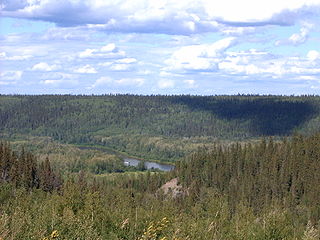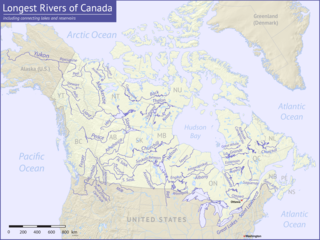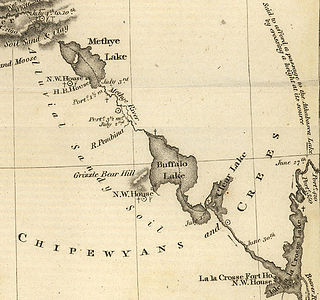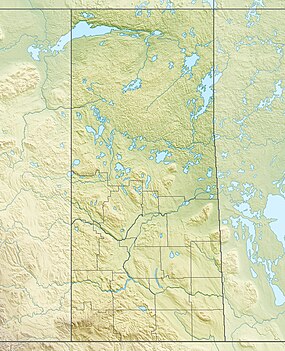
The Athabasca River is a river in Alberta, Canada, which originates at the Columbia Icefield in Jasper National Park and flows more than 1,231 km (765 mi) before emptying into Lake Athabasca. Much of the land along its banks is protected in national and provincial parks, and the river is designated a Canadian Heritage River for its historical and cultural importance. The scenic Athabasca Falls is located about 30 km (19 mi) upstream from Jasper.

The Chipewyan are a Dene Indigenous Canadian people of the Athabaskan language family, whose ancestors are identified with the Taltheilei Shale archaeological tradition. They are part of the Northern Athabascan group of peoples, and come from what is now Western Canada.

The Clearwater River is located in the Canadian provinces of Saskatchewan and Alberta. It rises in the northern forest region of north-western Saskatchewan and joins the Athabasca River in north-eastern Alberta. It was part of an important trade route during the fur trade era and has been designated as a Canadian Heritage River.

Cumberland House is a community in Census Division No. 18 in northeast Saskatchewan, Canada on the Saskatchewan River. It is the oldest community in Saskatchewan and has a population of about 2,000 people. Cumberland House Provincial Park, which provides tours of an 1890s powder house built by the Hudson's Bay Company, is located nearby.
The Methye Portage or Portage La Loche in northwestern Saskatchewan was one of the most important portages in the old fur trade route across Canada. The 19 km (12 mi) portage connected the Mackenzie River basin to rivers that ran east to the Atlantic. It was reached by Peter Pond in 1778 and abandoned in 1883 when steamboats began running on the Athabasca River with links to the railroad. It ranks with Grand Portage as one of the two most important and difficult portages used during the fur trade era.

Beaver River is a large river in east-central Alberta and central Saskatchewan, Canada. It flows east through Alberta and Saskatchewan and then turns sharply north to flow into Lac Île-à-la-Crosse on the Churchill River which flows into Hudson Bay.

The Fort McKay First Nation (FMFN) is a First Nations government in northeast Alberta comprising five Indian reserves – Fort McKay 174, Fort McKay 174C, Fort McKay 174D, Namur Lake 174B and Namur River 174A. The FMFN, signed to Treaty 8, is affiliated with the Athabasca Tribal Council and its members are of Cree, Metis and Dene heritage. The FMFN's traditional lands include portions of the Athabasca oil sands.

Île-à-la-Crosse is a northern village in Division No. 18, northwestern Saskatchewan, and was the site of historic trading posts first established in 1778. Île-à-la-Crosse is the second oldest community in Saskatchewan, Canada, following establishment of the Red River Colony in 1811. It sits at the end of a 20 km (12 mi) long peninsula on the western shore of Lac Île-à-la-Crosse, and is linked with Peter Pond Lake and Churchill Lake through a series of interconnected lakes, rivers, and portage routes.

The Sturgeon-Weir River is a river in east-central Saskatchewan, Canada. It flows about 130 km (81 mi) south-southeast to join the Saskatchewan River at Cumberland House, Saskatchewan. It was on the main voyageur route from eastern Canada northeast to the Mackenzie River basin. The river is a popular wilderness canoe route in Canada.

Amisk Lake is a lake in the east-central part of the Canadian province of Saskatchewan, about 22 kilometres (14 mi) south-west of Flin Flon, Manitoba. 'Amisk' means beaver in Cree. Saskatchewan Highway 167 provides road access. Denare Beach, the largest settlement, is located at the north-east corner of the lake.

This article covers the water based Canadian canoe routes used by early explorers of Canada with special emphasis on the fur trade.
Louis Primeau or Primo was one of the first European fur traders on the Churchill River. Primeau Lake in northern Saskatchewan, Canada is named after him. Little is known of his youth. Morton says that he was born in Quebec of an English father and French mother, but the DCB does not repeat this.
Fort Sturgeon (1776–1780) was the first trading post on the North Saskatchewan River. It was located about 4 miles west of Prince Albert, Saskatchewan. It and was also called Peter Pond Fort, Fort Pond, Fort la Prairie, Fort des Prairies, Lower Settlement and Fort Sturgeon River.
Pedlar is a term used in Canadian history to refer to English-speaking independent fur traders from Montreal who competed with the Hudson's Bay Company in western Canada from about 1770 to 1803. After 1779 they were mostly absorbed by the North West Company. The name was first used by the Hudson's Bay Company to refer to French coureurs des bois, who travelled inland to trade with the Indians in their villages and camps. This was in contrast to the HBC policy of building posts on Hudson Bay, to where the Indians would bring furs to trade with them.

In fur trade days the term Athabasca Country was used for the fur-producing region around Lake Athabasca. The area was important for two reasons. The cold climate produced some of the densest and thickest beaver fur in North America. The number of furs produced was somewhat greater than its only rival, the Saskatchewan River fur trade. Secondly, the great distance from Montreal and Hudson Bay required the highly developed and efficient transportation system that characterized the Hudson's Bay Company in the nineteenth century.

The Portage La Loche Brigade was a York boat fur brigade that travelled between Fort Garry, the Methye Portage and York Factory in Rupert's Land. This famous brigade travelled 4000 miles every year and was part of the Hudson's Bay Company transportation system during the North American fur trade. Their trip from Fort Garry to Portage La Loche would begin around 1 June and end around 8 October. Only one other brigade had a longer route. The York Factory Express brigade travelled 4200 miles from York Factory to Fort Vancouver until 1846.

The La Loche River is a small river in north-west Saskatchewan. The distance from its source at the south east end of Lac La Loche to its mouth at the north end of Peter Pond Lake is 56 km. The river is bridged by Highway 956 about 5 kilometres from its source. The Kimowin River flows in from the west.
Asleep by the frozen sea is a phrase coined by Joseph Robson to describe the policy of the Hudson's Bay Company (HBC) from its foundation in 1670 until the establishment of its first inland post in 1774. Unlike the French who sent Coureurs des bois inland to trade, the HBC built posts on Hudson Bay and waited for the Indians to bring furs to them. The decision to abandon this policy and move inland gradually turned the HBC into an informal government for western Canada and led ultimately to the confederation of western and eastern Canada.

Lac Île-à-la-Crosse is a Y-shaped lake in North-Central Saskatchewan, Canada, on the Churchill River. At the centre of the Y is the town of Île-à-la-Crosse, the second oldest town in Saskatchewan. The Churchill exits the north-east arm and flows east to Hudson Bay through a series of lakes. The Churchill enters at the north-west arm called Aubichon Arm or Deep River. Upstream it leads north-west to Athabasca Country passing Churchill Lake, Peter Pond Lake, Lac La Loche and on to the Methye Portage leading to Lake Athabasca.
















